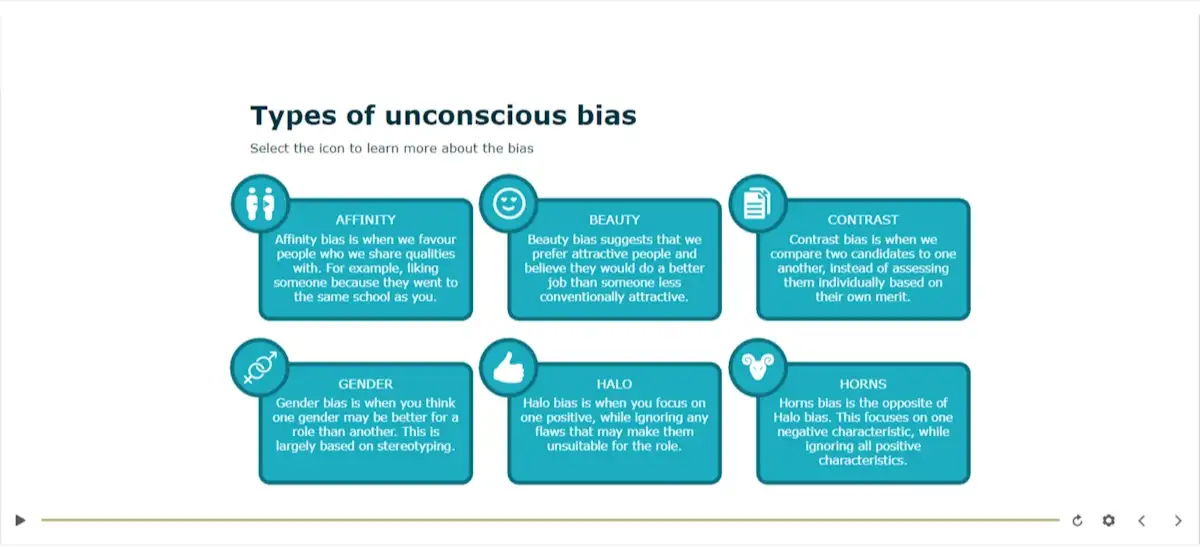Artificial Intelligence
Surprising Benefits And Pitfalls Of Using Artificial Intelligence In Training Courses
Growth in all things artificial intelligence (AI) is off the charts currently. It has enormous...
Read MoreDiversity in the workplace training refers to educational programs designed to increase awareness, understanding, and acceptance of differences among individuals. These differences can be related to race, gender, age, religion, disability, sexual orientation, nationality, and other personal characteristics. Diversity training aims to create a more inclusive and harmonious workplace where every individual feels valued, understood, and respected. Diversity training in the workplace can also drive innovation, enhance creativity, foster a more inclusive environment, and generate improved financial returns. But how do you instill these principles in your workforce via an online learning platform? Below, we discuss why diversity is important in the workplace, the advantages of online training, and how to overcome challenges using our top tips based on our extensive experience in creating diversity in the workplace training.
Diversity in the workplace refers to differences among people in an organization. It can encompass a broad spectrum of individual and group differences. For example, Diversity in the workplace includes:
“Diversity and Inclusion needs to be something that every single employee at the company has a stake in.” — Bo Young Lee, Uber’s Chief Diversity and Inclusion Officer.
First and foremost, Diversity in the workplace is essential for cultivating social justice and equity. Secondly, organizations have found why diversity is important is also because it enhances business performance. Below are some of the reasons why workplace diversity matters
It’s important to note that while having a diverse workforce is vital, it’s equally essential to ensure inclusion. Diversity without inclusion can still lead to marginalized groups feeling undervalued or unheard. Actual benefits arise when diverse voices are present and actively included and valued in decision-making processes and organizational culture.
“Inclusion is not a matter of political correctness. It is the key to growth.” — Jesse Jackson.
Nowadays, diversity and inclusion in the workforce is a natural necessity for most of us. But if you have individuals in your organization you still need to convince that Diversity in the workplace training has a high return on investment, show them some of the statistics below. It’s one of the reasons that Diversity training in the workplace is now one of the most popular courses organizations offer. Organizations have realized why diversity training is so important.
“In today’s interconnected and globalized world, it is now commonplace for people of dissimilar world views, faiths, and races to live side by side. It is a matter of great urgency, therefore, that we find ways to cooperate with one another in a spirit of mutual acceptance and respect.” – Dalai Lama.
Diversity in the workplace training is one, albeit important, component of creating diverse and inclusive workplaces. To maximize the impact of diversity training in the workplace, it must be part of a larger strategic initiative that has buy-in from leadership and is evaluated regularly and updated to reflect the organization’s evolving needs.
A training component is crucial in fostering an understanding an appreciation that diversity goes beyond merely hiring diverse talent. To truly create an inclusive environment, there needs to be an active commitment from all organization members to understand, respect, and value individual differences. Training can play a pivotal role in this process and online diversity training offers a range of advantages:
The ultimate goal of diversity training in the workplace is to create a more inclusive and harmonious workplace where every individual feels valued, understood, and respected. As such, you can develop several levels of diversity in the workplace training depending upon your organization’s existing training and needs.
Awareness building is often the first step in diversity training in the workplace. It is where participants are made aware of their own biases and prejudices, both conscious and unconscious. The idea is to recognize that regardless of background, everyone has biases that can influence their decisions and behavior.
Once participants recognize their biases, the next step is to develop skills to interact more effectively with people from diverse backgrounds. It might include communication skills, conflict resolution strategies, and techniques for building inclusive teams.
The ultimate aim of diversity training in the workplace is to change behavior. Participants are encouraged to apply their knowledge to create an environment where every employee feels included and valued. It can involve modifying how people provide feedback, hiring practices, or reshaping team dynamics.
Embedding the training and enhancing diversity and inclusion is the next level. Also it’s been demonstrated that when companies have inclusive cultures, they are:
The Diversity And Inclusion Revolution, Deloitte
As we’ve seen, online diversity training in the workplace has many advantages and can cover many levels. However, pursuing your diversity training goal successfully requires a thoughtful approach and overcoming some challenges. At Spark + Co., we’ve created many diversity training examples in the workplace for a variety of organizations, including
In developing numerous online training modules on many aspects of Diversity and Inclusion in the workplace, we’ve found some top tips to help create successful diversity training in the workplace, including how to overcome challenges and deal with difficult topics in this sensitive area.
Using authentic narratives in your Diversity in the workplace training courses is critical. Rather than telling people what they should or shouldn’t do, approaches such as reciting stories, showing authentic examples, and sharing personal experiences is much more impactful. The participant can then listen/watch and draw their own conclusions, which is much more effective. Also, a first-person narrative mode of storytelling is highly effective. The storyteller should recount events from their point of view using first person grammar such as ‘I,’ ‘me,’ ‘my’… Below are screenshots of diversity training examples from a course on Sexual Harassment. This particular aspect of diversity training in the workplace focuses on gender discrimination and using pronouns.

Before creating any training program, it’s essential to understand its purpose. Why is diversity important for your organization? Ensure that the training is rooted in real business goals, recruitment strategies, and societal benefits, such as improved performance, better decision-making, and representing the diverse customer base. When participants understand the “why,” they’re more likely to embrace the “how,” and the impact of your diversity training in the workplace will be more significant.
Playing it too safe with all your diversity training examples usually doesn’t achieve the behavioral changes that you may desire. And may not be authentic to the specific issues you are dealing with. So, without offending anyone, be courageous with the examples you use. Include diversity training examples or stories that make you squirm slightly, as these will evoke a reaction. You want your examples to be as authentic and human as possible. Learners will recognize that you are developing an unsanitized solution for a corporate audience by creating diversity in the workplace training that pushes the boundaries a little.
When working with our clients on designing online learning, we often collaborate and work with a stakeholder group or project team. The client team we work with must be diverse. Suppose the immediate team doesn’t have the required diversity. In that case, we’ll advise clients to recruit people from diverse backgrounds to review the content early in the development process.
For example, having an Indigenous perspective was critical for one client. But they also did not want to add to the workload of their Indigenous experts. So, the client hired an Indigenous person for the project to ensure that the language and perspective were culturally sensitive and appropriate.
Diversity and inclusion can be an emotionally sensitive topic. Many people are still learning and understanding the intricacies and nuances and how to apply them to their daily lives. So, to help the process and prevent offending anyone unintentionally, it’s a good idea to establish writing standards.
The journey to understanding diversity starts within. So, in your diversity in the workplace training, encourage participants to examine their biases, beliefs, and behaviors. You can achieve this through quizzes, reflective exercises, and open-ended questions. Individuals are better positioned to recognize, address, and challenge their unconscious biases.
Questions such as “What would you do in their shoes?” can provide reflective activity, a form of repetition and practice. And practice is a necessary part of learning. The diversity training examples below that you can click on and review, illustrate this type of approach.

Click the image to answer the questions in this activity of a Diversity in the workplace training course
Tailor your Diversity in the workplace course to your organizational context – what does it mean to your business outcomes? Why should the learner pay attention to diversity and inclusion at your organization? Learners often want to understand the specific context and impact on their workplace. So, address the unique diversity challenges that your organization or industry faces. And use customized content as it makes the course more relevant to them and will enhance your audience’s engagement. You should tailor the content to align with your organizational culture’s values and goals.
Different people and workplaces require different types of training and materials. So avoid adapting training materials created for a purpose different from yours.
As part of their workplace diversity training, a college asked the question “What does indigenization mean to me in my role at Douglas?” They recorded the answers of employees to show a way for individual to reflect on what it meant for them in their work.
While you should tailor your course to the specific circumstances within your organization, ensure you consider all forms of diversity. While race and gender are often the primary focus, diversity is multifaceted. Ensure your training includes age, sexual orientation, physical abilities, mental health, religious beliefs, neurodiversity, and socio-economic status. A comprehensive approach ensures that all employees can resonate with the content, even if you focus more detail on the most relevant aspects of your organization. People with “invisible” disabilities experience discrimination, so keep your definition of diversity as broad as possible.
Each individual brings a unique perspective based on their experiences. And learning from peers often leaves a lasting impression and builds empathy. So, where possible, create opportunities for learners to share stories, insights, and perspectives. You can facilitate this through discussion forums, group projects, and breakout sessions.
Diversity and inclusion are dynamic areas, evolving with societal changes, research findings, and emerging narratives. As with most courses, online diversity in the workplace training requires regular updating to ensure the content remains relevant, accurate, and aligned with the latest best practices and organizational policies.
Essential to any course, especially for diversity training in the workplace, is a need to create an online space where participants can discuss diversity topics openly. Establishing clear rules against discrimination at the start, demonstrating empathy, and creating a safe place for all are critical.
Use a blended learning approach where possible when creating your diversity in the workplace course. Consider a mix of e-learning modules, webinars, reading materials, and forums. This caters to different learning preferences and keeps engagement high. And if feasible, you could integrate face-to-face sessions to make certain activities more impactful.
You could use lots of free images and other content in your training. But these need to be authentic, which is one of the reasons to use the storyteller to tell their story. So, avoid stereotypes when using images, voice casting, and writing narratives. It prevents participants from listening to a voice or seeing a picture and thinking, ‘They don’t sound Asian enough’ or ‘look Indigenous enough.’ For example, using poorly selected ‘stock images’ can be viewed as tokenism.
Some resources we find valuable and helpful are
Diversity training is an integral part of creating a diverse and inclusive workplace. However, a course on its own isn’t going to achieve the results you desire. Suppose you aren’t genuine in your approach to diversity in hiring, promotion, and other programs. In that case, no amount of training will help.
For example, one of our recent clients provides some practical diversity training examples. They took steps to not just talk about diversity but created training for their managers on inclusive hiring. It included training on more equitable processes, creating a richer talent pool, and a practical toolkit for the managers. While not a complete solution, it demonstrates the work that will have a more profound impact.

Screenshot From An Inclusive Hiring Course Created For A Real Estate Development Company
Diversity and inclusion in the workforce is a prerequisite for most of us in the workplace. Organizations are also rapidly realizing the value of creating a more inclusive and harmonious workplace where everyone feels valued, understood, and respected. Results show that it can drive innovation, enhance creativity, foster a more inclusive environment, and generate improved financial returns. All this means that diversity in the workplace training is one of the most popular and demanded courses now. And while creating online diversity training in the workplace has many advantages, you now have 14 tips to overcome challenges and make your training a valuable, authentic, and successful part of your diversity and inclusion programs and practices.
Spark + Co has worked with over 70 clients since 2007, providing custom online courses. We help businesses, non-profits, and government agencies to achieve their training goals. Need to help creating custom diversity and inclusion training? That’s what we do, having created diversity and inclusion courses for many organizations and we’re ready to help. Book an initial consultation now, send us an email, or find out more from our website.